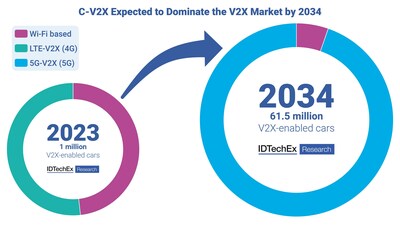TMCnet News
IDTechEx Discusses Low-Loss Materials: Enabler of Future Connected VehiclesBOSTON, May 2, 2024 /PRNewswire/ -- Future connected vehicles will offer future drivers a safer, smoother, and more convenient driving experience. Not only will drivers get access to more navigation and entertainment options, but they will also gain access to safety technologies that will potentially reduce accidents, improve congestion, and reduce emissions globally by allowing vehicle safety systems to communicate with each other and with city traffic infrastructure. This is thanks to the future connected vehicle's use of dedicated "V2X" safety communication channels. V2X (Vehicle-to-Everything) uses either Wi-Fi or cellular-based technology to facilitate communication with other vehicles and traffic infrastructure. If regulation or safety standards mandate this technology, then V2X is set to become the "digital seatbelt" of the future. The two most popular technologies for V2X, DSRC, and C-V2X, both require different hardware. DSRC is based on Wi-Fi protocols, and C-V2X is based on 4G or 5G protocols. Currently, there are approximately 1 million V2X-connected vehicles on the road globally. About half of the V2X-connected vehicle market is using C-V2X technology, with most of these vehicles being available in China. IDTechEx is forecasting a significant market shift towards C-V2X technology, with over 90% of the market forecasted to be using 5G-based C-V2X technology by 2034. The biggest contribution to this shift is regulation - the two largest vehicle markets in the world, the US and China, both have governmental organizations actively pushing for C-V2X adoption. India, Korea, and Japan are all likely to follow international trends set by the US and China. IDTechEx's analysis concludes that while DSRC technology may improve, C-V2X as a technology has much more momentum than DSRC. China alone is set to add 30 million new V2X-enabled vehicles to the road every year by 2034, with most of these using 5G-based C-V2X technology, according to IDTechEx's report, "Software-Defined Vehicles, Connected Cars, and AI in Cars 2024-2034: Markets, Trends, and Forecasts".  Photo - https://mma.prnewswire.com/media/2403197/IDTechEx_1.jpg C-V2X expected to dominate the market by 2034. Source: IDTechEx Which low-loss materials would C-V2X-enabled vehicles use? With so many C-V2X enabled vehicles set to come online in the nex decade, it begs the question: Which materials will the 5G components in such vehicles use? After all, the materials in 5G components, specifically low-loss materials, are critical technology enablers. 5G components, such as filters and antennas, struggle with high transmission loss. High transmission loss leads to poor signal propagation, which would severely limit the efficacy of 5G communications. Reducing this transmission loss is key to expanding the reach of 5G technology, including in connected vehicles, so it is critical to maximize the dielectric performance of materials found in 5G components. For these reasons, low-loss materials will be a relevant material enabler of C-V2X in connected vehicles. In fact, connected vehicles may represent a new market opportunity for low-loss materials in the future. As such, it is interesting to explore which low-loss materials would be suitable for the V2X-enabled vehicles market. The key factor determining which low-loss materials would be utilized for V2X 5G components is the frequency band V2X operates in. 5G telecommunications consists of two frequency bands: sub-6 GHz (3.5 – 7 GHz) and mmWave (24 – 71 GHz). Sub-6 GHz 5G is the most deployed 5G frequency band to date, comprising 78% of 5G deployments by 2022. As such, low-loss materials used in sub-6 GHz applications comprise about two-thirds of the 5G market by revenue in 2024, as estimated by IDTechEx's "Low-Loss Materials for 5G and 6G 2024-2034: Markets, Trends, Forecasts" report. C-V2X falls within the sub-6 GHz 5G band, having been assigned to the 5.9 GHz frequency band. In 2020, the United States Federal Communications Commission specifically allocated the frequency range 5.895 to 5.925 GHz to C-V2X. As such, the 5G components used for V2X will need to use low-loss materials suitable for the sub-6 GHz band. With performance requirements slightly higher than 4G, sub-6 GHz applications are often served by 4G low-loss materials. This includes incumbent epoxy dielectric materials, such as epoxy-based FR-4 and BT, which have numerous suppliers, as outlined in the IDTechEx report. Other materials used in 4G components like antennas include polyimide, used in 4G smartphone antennas. Other options that could serve this market are low-loss materials that offer balanced performance in the sub-6 GHz and mmWave bands, such as modified polyimide, liquid crystal polymers, and hydrocarbons. Factors impacting low-loss material selection include the balance of dielectric properties and moisture absorption with the cost of the material. As such, a number of low loss materials and suppliers may end up serving the V2X-enabled vehicle market in the future. For more information on the IDTechEx report "Low-Loss Materials for 5G and 6G 2024-2034: Markets, Trends, Forecasts", including downloadable sample pages, please visit www.IDTechEx.com/LowLossMats. For the full portfolio of 5G related research available from IDTechEx, please visit www.IDTechEx.com/Research/5G. To find out more about the IDTechEx report "Software-Defined Vehicles, Connected Cars, and AI in Cars 2024-2034: Markets, Trends, and Forecasts", including downloadable sample pages, please visit www.IDTechEx.com/CSDV. About IDTechEx IDTechEx provides trusted independent research on emerging technologies and their markets. Since 1999, we have been helping our clients to understand new technologies, their supply chains, market requirements, opportunities and forecasts. For more information, contact [email protected] or visit www.IDTechEx.com. Images download: Media Contact: Lucy Rogers Social Media Links: Twitter: https://www.twitter.com/IDTechEx Logo - https://mma.prnewswire.com/media/478371/IDTechEx_Logo.jpg 

|
